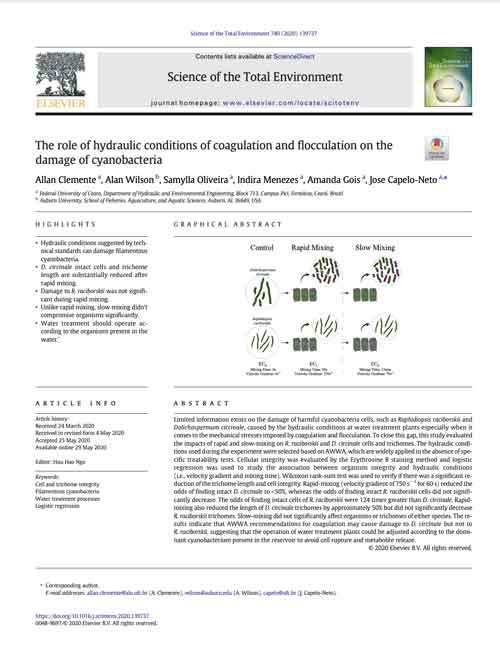Keyword: Filamentous cyanobacteria

Clemente, A., A. E. Wilson, S. Oliveira, I. Menezes, A. Gois, and J. Capelo-Neto. 2020. The role of hydraulic conditions of coagulation and flocculation on the damage of cyanobacteria. Science of the Total Environment 740:139737.
Abstract
Limited information exists on the damage of harmful cyanobacteria cells, such as Raphidiopsis raciborskii and Dolichospermum circinale, caused by the hydraulic conditions at water treatment plants especially when it comes to the mechanical stresses imposed by coagulation and flocculation. To close this gap, this study evaluated the impacts of rapid and slow-mixing on R. raciborskii and D. circinale cells and trichomes. The hydraulic conditions used during the experiment were selected based on AWWA, which are widely applied in the absence of specific treatability tests. Cellular integrity was evaluated by the Erythrosine B staining method and logistic regression was used to study the association between organism integrity and hydraulic conditions (i.e., velocity gradient and mixing time). Wilcoxon rank-sum test was used to verify if there was a significant reduction of the trichome length and cell integrity. Rapid-mixing (velocity gradient of 750 s−1 for 60 s) reduced the odds of finding intact D. circinale to <50%, whereas the odds of finding intact R. raciborskii cells did not significantly decrease. The odds of finding intact cells of R. raciborskii were 124 times greater than D. circinale. Rapid mixing also reduced the length of D. circinale trichomes by approximately 50% but did not significantly decrease R. raciborskii trichomes. Slow-mixing did not significantly affect organisms or trichomes of either species. The results indicate that AWWA recommendations for coagulation may cause damage to D. circinale but not to R. raciborskii, suggesting that the operation of water treatment plants could be adjusted according to the dominant cyanobacterium present in the reservoir to avoid cell rupture and metabolite release
Tillmanns, A. R., A. E. Wilson, F. R. Pick, and O. Sarnelle. 2008. Meta-analysis of cyanobacterial effects on zooplankton population growth rate: species-specific responses. Fundamental and Applied Limnology 171(4):285-295.
Abstract
We analyzed a large data set of laboratory experiments to examine the effects of cyanobacteria containing or lacking intracellular toxic metabolites and of different morphology on zooplankton population growth rates across multiple genera and species of cladocerans, rotifers and cyanobacteria. Twenty-one of the 29 zooplankton species maintained positive growth rates when fed a diet containing cyanobacteria even though cyanobacteria were a poor food source for half of the zooplankton species tested relative to a diet containing only green algae and/or flagellates. Differences among zooplankton species could not be explained by grazer species body lengths, even when experiments were restricted to those that used only filamentous cyanobacteria. Single-celled cyanobacteria were more detrimental to a larger number of zooplankton species compared to filamentous or chroococcoid colonial cyanobacteria. We also found no clear effect of putative cyanobacterial toxins on the growth of seven zooplankton species but we did detect a negative effect for the largest cladoceran species, Daphnia magna. Among the cyanobacterial genera, Microcystis had the largest negative effect on zooplankton population growth and there was no consistent difference between M. aeruginosa strains that produced microcystins and those that did not. Our results highlight the large variation in species-specific responses of zooplankton to cyanobacteria. Although cyanobacterial toxicity and mechanical interference may be important drivers in particular cyanobacteria-zooplankton interactions, we did not find general support for these mechanisms through the use of this meta-analysis.